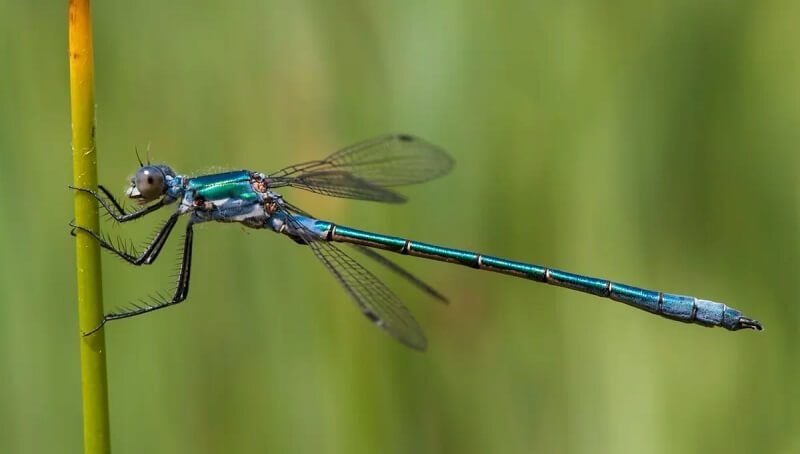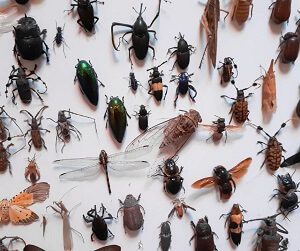
How To Treat, Identify, and Prevent Worms in Dog Poop
September 23, 2022
Interesting Facts About the Manatee
September 25, 2022
First off, what are insects?
The structure of insects is based on an unchanged structure for hundreds of millions of years: the body consists of three segments, head, thorax, and abdomen, with two pairs of wings, three pairs of legs, and two compound eyes.
But this basic structure declines in countless variations, which are as many as the needs of adapting to an environment.
Insects are the largest group of animals. There are more than a million known species, but experts estimate there are at least ten million, and some, more optimistic, say there may be as many as 70 million.
We live, according to scientists, in an “insect age”, a more fascinating age, as we still have millions of species to discover.
Insects appeared about 400 million years ago, and almost all orders of insects that existed 200 million years ago have representatives in today’s fauna. It’s an impressive example of survival, the result of perfect adaptation to the most diverse living conditions.
Are insects animals?
The answer to this question is resounding, but, yes, insects are animals. Now let’s look at why.
Archaea, Bacteria, and Eukarya are the three taxonomic domains. The first two mainly include single-celled organisms, but only Eukarya exhibits organisms with cellular nuclei. Does that mean everything in Eukarya is an animal? No, it’s not. To reach this point, we must move to the “Kingdoms”.
After all, trees are multiple cellular organisms with nuclei, but the third is not obviously an animal! Therefore, at the level of the “Kingdom”, there is a classification known as Animalia. The species grouped in the animal kingdom have several common features:
- They reproduce sexually;
- Breathe oxygen;
- Consume organic material;
- They are able to move.
With a small number of exceptions, all animals meet these basic criteria. So, the next time you are asked whether insects are animals, you can say they are because they reproduce sexually, breathe oxygen, consume organic material, and are able to move”.
What percentage of the animals in the world are insects?
Now that we have established that insects are animals, let us see exactly what percentage of the Animal Kingdom is represented by insects.
Today there are approximately 1 million known insect species. This represents about 70% of all animal species. In total, along with invertebrates, which include arachnids, crustaceans, and other species, represent 96% of all identified animal species.
You might also like my articles on:
When you compare the number of insects, under the “insect class”, you see the amazing biodiversity of insects.
Number of species (Chapman, 2009)
- Insects: ~ 1.000.000
- Mammals: 5.487
- Birds: 9.990
- Reptiles: 8.734
- Fish: 31.153
- Amphibians: 6.515
Most importantly, the percentage of insects compared to other animals should continue to increase in the coming decades.
What is the explanation for this evolutionary success?
We don’t know everything, but some of the reasons could be:
The adaptability of insects
Insects are a group with great plasticity, evolving rapidly and adapting to changes, new situations, and opportunities.
Phytophagous insects eat a large number of plants, while other insects feed on animals, vertebrates, or invertebrates, dead or alive. There are also a bunch of insects that eat “our” food, including heat-processed, cooked food, clothes, feathers, blood, cork stoppers, paper, dung, and almost anything else!
The ability to fly
It is a quality that allowed insects to spread and conquer new territories.
Metamorphosis
It is one of the most fascinating features of insects. They go through several stages of life. The larvae being much different from adults gives them the opportunity to exploit other food resources.
The external skeleton
A true technological wonder. Composed mostly of chitin, it is lightweight, flexible, and also very resistant to chemical and mechanical aggression. From this excellent material, nature has produced a huge variety of designs. And today, insects continue to evolve, adapt and spread. Optimistic scientists say insects will continue to live on Earth long after we, humans, will no longer be.
Multi-function Appendix
Their three pairs of legs can have the most varied appearance, with claws for hanging (on lice), wider parts that serve swimming (on aquatic insects), and adhesive discs for holding on different surfaces – this is how flies manage to stand on a smooth vertical wall, and many others.
Born to jump
Order of the Orthoptera
In crickets and locusts, the hind legs are designed for jumping. Very long, with strong muscles, they developed a considerable force that propels the insect’s body a few meters away. This is a remarkable performance for a creature of only a few centimeters long.
Their weapon is their foot
The order of the Mantodea
Predator insects, the praying mantis, have as their main weapon of attack the pair of anterior legs. Knife blade mechanism, plus toothed edges like saws, plus catch speed equal effective and scary attack weapons.
The praying mantis is able to capture in a fraction of a second prey of their size or even larger. Large species of exotic praying mantis can capture, besides insects and spiders, small vertebrates such as frogs, lizards, rodents, or hummingbirds. These insects are famous for the fact that females tend to devour, after mating, males of their own species.
Thousands of facets
Compound eyes. Each facet faces a different direction from its neighbors. They capture a general impression of the color and luminous intensity of a portion of the object being watched and transmit a fragment of the total image. Insects can only see well at short distances, but they can sense extremely fine movements.
The wings
Insects were the first winged creatures to appear on Earth. Although there are species without wings, most insects have wings, and these are among the most important characteristics of their classification. By the appearance of the wings, a butterfly is clearly distinguished from a dragonfly, for example, or a cockroach.
Shapes and colors – Camouflage
Sometimes, insects’ silhouettes mimic so well certain parts of plants that the result is an enviable camouflage. What appears to be a branch, a leaf, or a flower may actually be an insect. Even the thorns of plants can become the “inspiration” for some insects.
Adapted models
Sometimes, insects’ body structures represent functional adaptations to flight, as are the thin and elated bodies of dragonflies. Other times, they are durable, compact constructions, as in the case of almost semi-ferric bodies of ladybugs.
A million species
 We live in the age of insects. They are invertebrates with segmented bodies and constitute the largest group of animals. There are about a million known species, exceeding the number of all other species of animals. What is the reason behind their success? They are the only arthropods capable of flight.
We live in the age of insects. They are invertebrates with segmented bodies and constitute the largest group of animals. There are about a million known species, exceeding the number of all other species of animals. What is the reason behind their success? They are the only arthropods capable of flight.
They have conquered all living environments, as they can use the most diverse sources of food. They play an important role in nature and in human life. Some insects cause man a lot of trouble because they damage crops and stored products, or transmit diseases.
But let’s not just talk only about the bad. Insects are also the most important pollinators, and predatory species regulate the number of harmful ones. Some recycle decomposing organic matter, others produce honey, wax, and silk. Let’s not forget the joy of admiring the beauty of butterflies, the elegant flight of dragonflies, the wonderful shapes and colors of cockroaches, or the song of crickets. Get to know them better.
Facts about insects
- Because the ratio of their body weight to body surface area is so high, they can achieve huge physical wonders.
- The insect resists a fall because its minimum weight means it lands with much less force. The surface of insects creates a lot of resistance when moving through the air.
- Research shows that mosquitoes are more active during the full moon. In fact, they can bite up to 5 times more.
- We taste with the tongue, but insects have no tongue. Instead, they taste with their antennae or flies. At least most of them do. Butterflies taste their food in a unique way. They taste with their feet. They land on foods using special chemical receptors from the feet to know the taste of food before they eat it.
- Did you know that moths can’t fly when an earthquake hits? Moths use a gyroscopic system to fly. Their wings and antennas function as a gyroscope, which is like a spinning wheel suspended by three rings. It is not a very stable system, therefore moths are not the best at flying.
- Due to their modified legs and light body, flies can go upside down on the ceiling.
- If we count all the types of land animals we know so far, from rodents to humans and everything in between, then this amount still reaches just one-third of the known insect species.
- Some scientists estimate that the actual number of different insect species could reach up to 30 million. Unfortunately, many of them will disappear just before they are found.
- While the greatest number and diversity of insects are found in the tropics, an extraordinary number of insect species can also be found in Poland.
- Over a thousand types of insects can appear in the backyard of a house, often with a population of many millions per acre. Several insect enthusiasts have researched and documented hundreds, sometimes thousands, of unique species in their own yards.
- The number of insect species is estimated at six to ten million.
- Some insects, such as water striders, can move to the surface of the water. They break down their low body weight in a way that maximizes the surface tension of water.
- Bees, termites, and ants live in well-organized social colonies.
- Insects are cold-blooded.
- Most insects hatch from eggs.
- Some Cicadas can make the sounds reach 120 decibels in volume.
- The life cycle of mosquitoes consists of four stages: Egg, larva, chrysalis, and adult. Female mosquitoes drink blood to get the nutrients they need to produce eggs.
- Spiders are not insects.
- Insects have two antennas and three pairs of legs.
- Bees are found on all continents except Antarctica.
- Ants leave the pathways and communicate with each other using pheromones as chemical signals.
